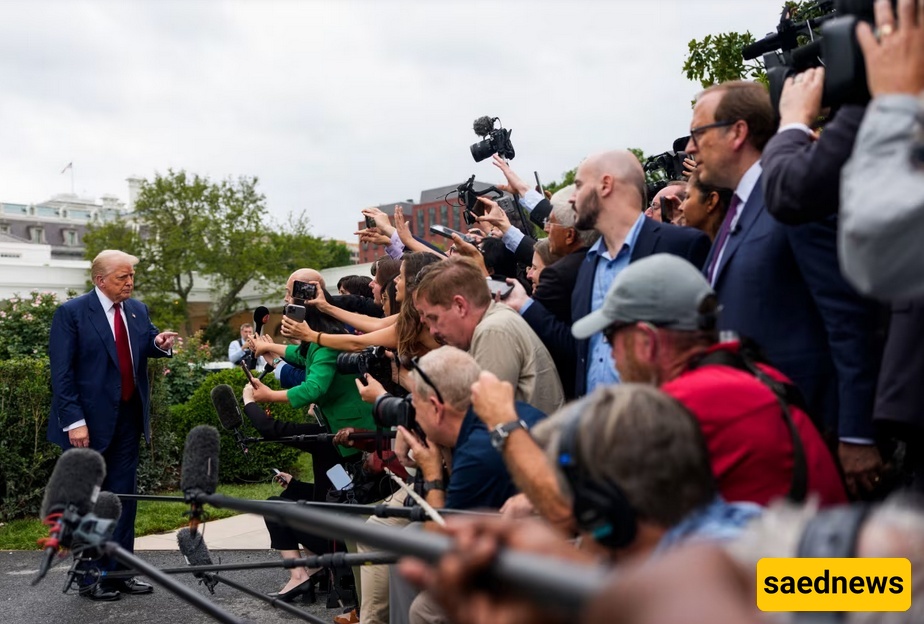SAEDNEWS: Donald Trump has once again blurred the line between reality and narrative by selectively interpreting employment statistics. While official data presents a different picture of the labor market, Trump offers a parallel and optimistic account aimed at strengthening his election campaign.

According to SaedNews, citing CNN, in recent weeks, Donald Trump has once again presented his own narrative of economic realities. At his campaign rallies, he has explicitly claimed that the United States is facing its worst employment situation, with millions of jobs lost, and accused the Biden administration of manipulating statistics to portray a better condition than reality. This stands in stark contrast to the latest official data from the U.S. Department of Labor, which shows a very different picture of the labor market: the unemployment rate remains at 3.9%, and on average, over 220,000 new jobs have been created each month over the past quarter.
Political analysts and media commentators view Trump’s approach to official data as troubling. While statistical distortion by politicians is not a new phenomenon, what Trump is doing goes beyond typical interpretation or exaggeration; he is effectively creating a parallel reality that is more acceptable to a large portion of his supporters than the official figures. This trend reflects the same strategy he has repeatedly employed since 2016: undermining the country’s statistical, scientific, and media institutions and replacing them with personalized and emotionally charged narratives.
In line with this, Trump has once again accused institutions such as the Bureau of Labor Statistics, the Congressional Budget Office, and even the Federal Reserve of “lying,” alleging that these bodies are colluding with the Biden administration. His attempt with these claims is not only to weaken the rival government but also to lay the groundwork for questioning the results of the upcoming election—just as he did in 2020 with his allegations of widespread fraud, which paved the way for the violent events of January 6.
Contrary to these claims, existing evidence points to a relative improvement in the United States labor market. Labor force participation has increased, and employment in manufacturing, technology, and service sectors has shown an upward trend. States such as Pennsylvania, Ohio, and Florida—often cited by Trump as examples of economic crisis—have experienced rising per capita incomes and declining unemployment rates in the past quarter. Even many conservative economists criticize Trump for ignoring economic realities and effectively presenting a misleading picture of the country’s situation.
However, the key question remains: to what extent can these election narratives influence the political and social realities of the United States? For Trump’s loyal supporters, these narratives are fully acceptable. A segment of American society has long distrusted mainstream media, government institutions, and even scientific data, viewing Trump as the only trustworthy source. He has succeeded in creating an alternative reality among this group, where he is the hero of truth and a victim of a corrupt system.
On the other hand, independent and moderate voters, especially in key states, view this approach with skepticism. According to a Gallup poll, only one-third of independent voters trust Trump’s economic analyses. This issue could play a decisive role in the upcoming election, as winning over moderate voters is crucial for success in national contests.
From a democratic perspective, the main danger of Trump’s narrative-building lies not only in distorting facts but also in damaging public trust in key institutions. If the former U.S. president can delegitimize official statistics and replace them with his own narratives, what guarantees exist that people will trust election results, health data, or security warnings in the future? This growing distrust lays the groundwork for repeating unrest similar to the Capitol riot—a scenario that many U.S. security and political institutions have warned could recur.
Meanwhile, media outlets, universities, and civil society face a serious challenge: how to distinguish fact from fabrication in an era when emotions, personal beliefs, and social media algorithms hold more power than evidence? In a recent report, the Brookings Institution warned that “the battle between truth and narrative will be America’s most important political confrontation in the coming decade,” and the only way to counter it is through public education, continuous transparency, and defending independent institutions.
Ultimately, what appears on the surface as an electoral battle between Trump and Biden is, at deeper levels, a conflict between two views of reality: one based on empirical data and the other on personal feelings. The outcome of this struggle will determine not only the fate of the 2024 election but also the future course of American democracy.

